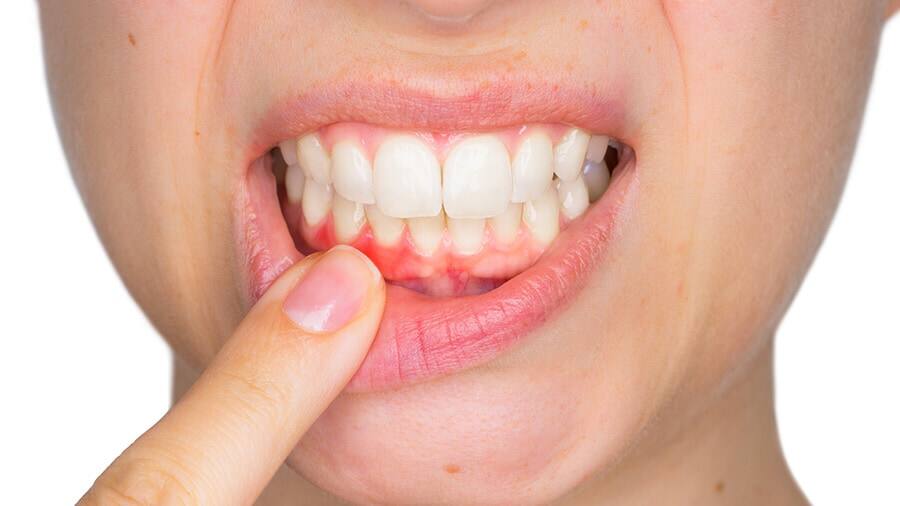What is Gum Disease?
Gum disease refers to a range of inflammatory conditions affecting the tissues surrounding the teeth. The most common form of gum disease is gingivitis, which is characterised by redness, swelling, and bleeding of the gums. If gingivitis progresses without treatment, it can lead to periodontitis, a more severe form of gum infection that can result in tooth loss and other systemic diseases and health conditions.
The primary cause of gum disease is plaque buildup on teeth due to poor oral hygiene. Dental plaque is a sticky film of bacteria that forms on teeth and can harden into tartar if not removed through regular brushing and flossing. When plaque accumulates, it irritates the gums and triggers an inflammatory response. Over time, this can lead to gum infection and damage to the supporting structures of the teeth.
What are the Symptoms of Gum Disease?
Recognising the symptoms of gum disease is essential for timely intervention. The symptoms can vary based on the severity of the condition.
Early Symptoms
In the early stages, symptoms of gum disease may be mild and easily overlooked. Common early signs include:
Red or swollen gums: Healthy gums should be pink and firm; any discolouration or puffiness indicates inflammation.
Bleeding during brushing or flossing: This is often one of the first noticeable signs; if your gums bleed regularly while brushing your teeth, it is a warning sign.
Persistent bad breath: Also known as halitosis, this can be an indicator of gum infection due to bacteria buildup.
Sensitivity: Increased sensitivity to hot or cold food and beverages may occur as inflammation develops.
These early symptoms should not be ignored. They indicate an inflammatory response in the gums that requires attention. Ignoring these signs can lead to more severe problems down the line.
Advanced Symptoms
As gum disease progresses, the symptoms of gum disease become more severe:
Receding gums: Gums may pull away from teeth, exposing more of the tooth or its root and creating pockets that trap food particles.
Formation of pockets between teeth and gums: These pockets can trap food and bacteria, leading to further infection.
Loose teeth: Advanced gum disease can lead to tooth mobility due to loss of supporting bone.
Painful chewing: Discomfort while eating can occur as the condition worsens; this may deter individuals from eating properly.
If you experience these advanced symptoms, it is crucial to seek dental care immediately. The longer you wait, the more difficult treatment may become.
Causes and Risk Factors for Gum Disease
Understanding what causes gum disease is essential for prevention. The primary cause is plaque buildup on teeth due to poor oral hygiene practices. However, several other factors can contribute to its development:
Smoking or tobacco use: This significantly increases the risk of gum disease by impairing blood flow to gums and reducing healing capacity.
Hormonal changes: Events such as pregnancy or menopause can make gums more susceptible to inflammation due to hormonal fluctuations.
Certain medical conditions: Diabetes, heart disease, and autoimmune diseases can affect gum health by compromising the immune system or blood flow.
Medications: Some drugs reduce saliva flow (which protects gums), increasing susceptibility to gum infections.
Nutritional deficiencies: A diet low in vitamins (especially vitamin C) can weaken gum tissue and impair healing.
Stages of Gum Disease
Gum disease progresses through several stages:
Gingivitis: The earliest stage characterised by inflammation and bleeding. At this point, damage is usually reversible with proper care.
Mild Periodontitis: Increased inflammation with some loss of bone support around teeth; pockets begin to form.
Moderate Periodontitis: More significant bone loss occurs; symptoms become more pronounced, including persistent bad breath and sensitive teeth.
Severe Periodontitis: Extensive damage occurs; teeth may become loose or fall out due to significant loss of supporting structures.
Each stage requires different levels of intervention; consulting a periodontist for early detection is critical for effective treatment.
When to See a Dentist?
If you notice any symptoms of gum disease, especially bleeding gums or persistent bad breath, it is time to consult a dentist. Regular dental check-ups are essential for monitoring oral health and catching potential issues early. It is recommended that adults visit their dentist at least twice a year for routine cleanings and examinations.
During these visits, your dentist will assess your gum health using tools such as probing measurements (to check for pocket depths) and X-rays (to evaluate bone loss). If you notice any changes in your oral health between visits—such as increased bleeding or discomfort—do not hesitate to schedule an appointment sooner.
Treatment Options for Gum Disease
Effective gum infection treatment begins with professional care, including thorough gum treatment to address the underlying issues. Understanding how to treat gum disease is essential for successfully treating gum disease and maintaining long-term oral health.
There are various approaches to managing gum infections:
Professional Cleanings: Regular dental cleanings, a common nonsurgical treatment, help remove plaque and tartar that contribute to gum disease. Your dentist or hygienist will use specialised tools to clean below the gumline where brushing cannot reach effectively.
Scaling and Root Planing: This deep-cleaning procedure removes plaque from below the gumline and smooths out rough spots on tooth roots where bacteria gather. This treatment helps reduce inflammation and allows gums to heal.
Medications: In certain cases, antibiotics may be prescribed either in pill form or as a topical gel applied directly to infected areas. These medications help control bacterial infection in more severe cases.
Gum Surgery: In advanced cases where significant tissue damage has occurred, surgical options such as flap surgery (lifting back gums for cleaning) or bone grafts (to restore lost bone) may be necessary to restore healthy tissue.
What is The Best Way to Prevent Gum Disease?
To prevent gum disease, it involves maintaining good oral hygiene practices:
Brush twice daily with fluoride toothpaste: Proper brushing technique removes plaque effectively.
Floss daily: Flossing helps remove plaque between teeth where toothbrushes cannot reach.
Regular dental visits: Professional cleanings every six months help keep your mouth healthy.
Healthy diet: A balanced, vitamin-rich diet supports overall health and reduces plaque buildup.
By following these guidelines on how to prevent gum disease naturally, you can significantly lower your risk. Additionally, consider using mouthwash containing antibacterial properties for added protection against plaque buildup.
Understanding what causes gum infections, the symptoms of gum disease and taking proactive measures can help maintain your oral health. Early intervention is key in preventing progression to more severe forms of periodontal disease. If you notice any signs or symptoms—such as bleeding gums or persistent bad breath—do not hesitate to contact your dental hygienist for advice tailored to your specific needs.
Maintaining good oral hygiene practices not only protects your gums but also contributes positively to your overall healthcare. Remember that healthy gums are foundational for healthy teeth!
Frequently Asked Questions
Can gum disease cause tooth pain?
Yes, advanced stages of gum disease can lead to tooth pain due to inflammation affecting surrounding tissues. It may also result from loose teeth caused by bone loss.
How to remove gum disease at home?
While home care can help manage mild symptoms through diligent brushing and flossing, professional dental treatment is necessary for effective removal of established gum disease.
Can salt water remove gum disease?
Rinsing with warm salt water may help soothe inflamed gums but will not eliminate existing gum disease; professional care is essential for effective periodontal treatment.
How to prevent gum disease naturally?
Maintaining good oral hygiene practices such as regular brushing with fluoride toothpaste, daily flossing, a balanced diet rich in vitamins (especially vitamin C), staying hydrated, avoiding tobacco products, and routine dental check-ups are effective natural prevention methods.














